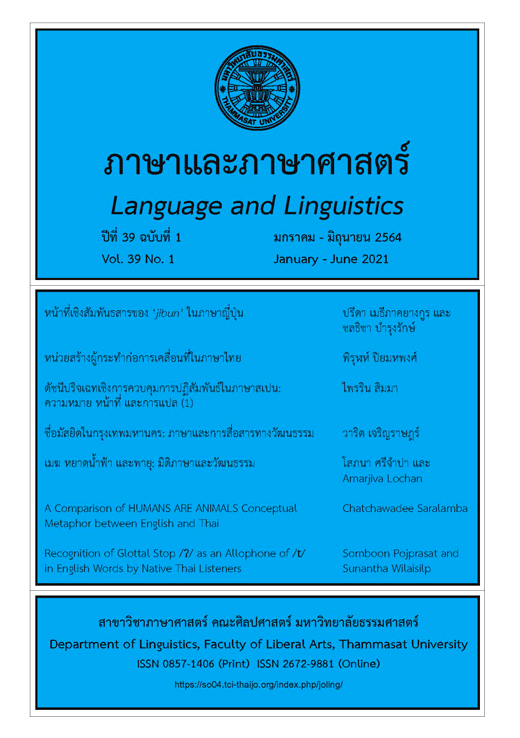Recognition of Glottal Stop /ʔ/ as an Allophone of /t/ in English Words by Native Thai Listeners
Main Article Content
Abstract
Some native speakers of English pronounce /t/ in certain words such as written, mountain, and button as the glottal stop /ʔ/. That is to say, the latter sound for some native English speakers serves as a variation of the former sound. This practice seems, we assume, unfamiliar to Thai learners of English, to whom sound variation is not often taught in a formal classroom. Thus, we aim to explore to what extent native Thai listeners can recognize the glottal stop /ʔ/ as a variation; to be more precise in this study as an allophone of the phoneme /t/ in English words. Methodologically, the participants listened to 15 English words, all of which contained an intervocalic glottal stop as the /t/ allophone. They were then asked to write the words they heard together with their meanings in Thai orthography in order for us to examine the level of their recognition of the sound in question as well as their matching of the glottal stop to Thai corresponding sounds. Results have shown a fairly low level of the participants’ ability to recognize the glottal as an allophone of /t/ in English words, and the most frequent correspondence was sound omission. We make a pedagogical suggestion pertaining to the glottal stop /ʔ/ as an allophone of the phoneme /t/ in the final section of the paper.
Article Details
บทความทุกบทความเป็นลิขสิทธิ์ของภาษาและภาษาศาสตร์
References
Best, C.T. (1993). Emergence of language-specific constraints in perception of non-native speech contrasts: A window on early phonological development. In B. de Boysson-Bardies, S. de Schonen, P. Jusczyk, P. MacNeilage, & J. Morton (Eds.), Developmental neurorecognition: Speech and face processing in the first year of life (pp. 289-304). Kluwer Academic.
Best, C. T. (1994). Learning to perceive the sound pattern of English. In C. Rovee-Collier & L. Lipsitt (Eds.), Advances in infancy research (Vol. 9, pp. 217-304). Ablex.
Best, C. T. (1995). A direct realist perspective on cross-language speech perception. In W. Strange (Ed.), Speech perception and linguistic Experience: Theoretical and methodological issues in cross-language research (pp. 171-204). York Press.
Best, C. T., & Hallé, P.A. (2010). Perception of initial obstruent voicing is influenced by gestural organization. Journal of Phonetics, 38(1), 109-126.
Best, C. T., & Strange, W. (1992). Effects of phonological and phonetic factors on cross-language perception of approximants. Journal of Phonetics, 20(3), 305-330.
Best, C. T., McRoberts, G. W., & Goodell, E. (2001). Discrimination of non-native consonant contrasts varying in perceptual assimilation to the listener’s native phonological system. The Journal of the Acoustical Society of America, 109(2), 775–794.
Byram, M., & Hu, A. (Eds.). (2013). Routledge encyclopedia of language teaching and learning (2nd ed.). Routledge.
Changjai, N. (2015). Evolution of the Thai language. Ramkhamhaeng University Press.
Eddington, D., & Channer, C. (2010). American English has go? a lo? of glottal stops: Social diffusion and linguistic motivation. American Speech, 85(3), 338-351.
Flege, J. E. (1995). Second language speech learning: Theory, findings, and problems. In W. Strange (Ed.), Speech perception and linguistic experience: Issues in cross-language research (pp. 233-277). York Press.
Flege, J. E. (2002). Interactions between the natives and second-language phonetic systems. In P. Burmeister, T. Piske, & A. Rohde (Eds.), An integrated view of language development: Papers in honour of Henning Wode (pp. 217-244). Wissenschaftlicher.
Fromkin, V., Rodman, R., & Hyams, N. (2003). An introduction to language (7th ed.). Thomson/Heinle.
Isac, D., & Reiss, C. (2008). I-language: An introduction to linguistics as cognitive science. Oxford University Press.
Jakielski, K. J., & Gildersleeve-Neumann, C. (2018). Phonetic science for clinical practice: A transcription and application workbook. Plural Publishing.
Kanchanawan, N. (2015). Analysis of Thai structure (7th ed.). Ramkhamhaeng University Press.
Kanokpermpoon, M. (2007). Thai and English consonantal sounds: A problem or a potential for EFL learning?. The ABAC Journal, 27(1), 57-66.
Khamkhien, A. (2010). Thai learner’s English pronunciation competence: Lesson learned from word stress assignment. Journal of Language Teaching and Research, 1(6), 757-764.
MacMillan dictionary (2nd ed.). (2007). MacMillan Publishers.
McAllister, R., Flege, J. E., & Piske, T. (2002). The influence by native speakers of Spanish, English, and Estonian. Journal of Phonetics, 30(2), 229-258.
Narksompong, J. (2007). A study of Thai phonological features that cause pronunciation problems for Thai people [Unpublished master’s thesis)]. Thammasat University.
Polka, L. (1992). Characterizing the influence of native language experience on adult speech perception. Perception & Psychophysics, 52(1), 37-52.
Sahatsathatsana, S. (2017). Pronunciation problems of Thai students learning English phonetics: A case study at Kalasin University. Journal of Education Maharakham University, 11(4), 67-84.
Sound American. (2017, December 4). Consonant sound glottal 'T' /ʔ/ as in "button" – American English pronunciation [Video]. http://www.youtube.com/watch?v=Vja83KLQXZs


